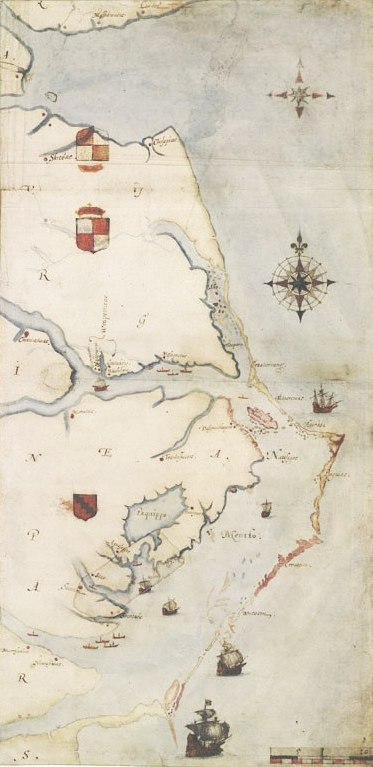 Newly found markings on an old map could give researchers the answers they’ve been looking for as to what could have happened to the lost colony of Roanoke.
Newly found markings on an old map could give researchers the answers they’ve been looking for as to what could have happened to the lost colony of Roanoke.
Having been the first permanent English settlement in the late 16th century, Roanoke colony and its colonists mysteriously vanished three years after England had shipped them supplies. The English had ran into problems reaching the colony because of the conflicts in the Anglo-spanish war that was happening at the time.
When England was finally able to reach the colony in 1590 it was already too late. The colony was deserted. No sign of the 90 men, 17 women, and 11 children were found. Their forts and shacks had been dismantled properly, pointing at the fact that their departure was not rushed. The only clues left were the words “Cro” & “Croatoan” carved in the nearby trees.
Now, researchers believe to have found hidden markings on an old map that could help solve this mystery. According to the British Museum’s re-examinitaion of the maps, the marks point to the colonists abandoning the coast and resettling at a different location.
Full source:
Map’s Hidden Marks Illuminate and Deepen Mystery of Lost Colony
By THEO EMERY
Published: May 3, 2012
For centuries, the Tidewater coast of North Carolina has held one of early America’s oldest secrets: the fate of more than 100 English colonists who vanished from their island outpost in the late 1500s.
Theories abound about what happened to the so-called Lost Colony, ranging from sober scholarship to science fiction. Some historians believe that the colonists might have been absorbed into American Indian tribes. Other explanations point to darker fates, like disease, an attack by Spaniards or violence at the hands of Indians. The wild-eyed fringe hints at cannibalism and even alien abduction.
The shroud of mystery may finally be lifting. The British Museum’s re-examination of a 16th-century coastal map using 21st-century imaging techniques has revealed hidden markings that show an inland fort where the colonists could have resettled after abandoning the coast.
The findings, announced Thursday morning, bring into focus a puzzle that has long fed the feverish curiosity of historians, archaeologists and amateur sleuths. Folklore has flourished over the colonists’ fate, including that of the first child of English descent born in the Americas, Virginia Dare.
And the findings point to new mysteries. The analysis suggests that the symbol marking the fort was deliberately hidden, perhaps to shield it from espionage in the spy-riddled English court. An even more tantalizing hint of dark arts tints the map: the possibility that invisible ink may have marked the site all along.
James Horn, vice president of research and historical interpretation at the Colonial Williamsburg Foundation, cautioned that the Lost Colony had not been found. But the findings do provide the clearest marker yet for future archaeological excavations, which, if successful, could pinpoint where the settlers went.
“It’s a pretty amazing piece of evidence from a source that has been staring us in the face all along,” said Mr. Horn, who joined historians with an organization called the First Colony Foundation to announce the findings.
The discovery came from a watercolor map in the British Museum’s permanent collection that was drawn by the colony’s governor, John White. Hoping to establish a New World foothold for the English, White took the settlers to their original location, Roanoke Island, just inside the chain of barrier islands known today as the Outer Banks.
It was the second English settlement on North Carolina’s coast, but it was the first to include civilians, among them wives, sons and — within weeks of their arrival in 1587 — White’s newborn granddaughter, Virginia Dare.
White returned to England for supplies, but an attack by the Spanish Armada delayed his return for three years. When he did return, the settlers had vanished.
Over time, the colony has spawned endless speculation and mythology, with Virginia Dare as its face. A 1937 Postal Service stamp featured her image as a baby. Time magazine included her among “top 10 famous disappearances,” along with the Lindbergh baby and Amelia Earhart. A flavor extract company based in Brooklyn bears her name. A vampire killer loosely fashioned around her story appears in a horror series.
6 comments



